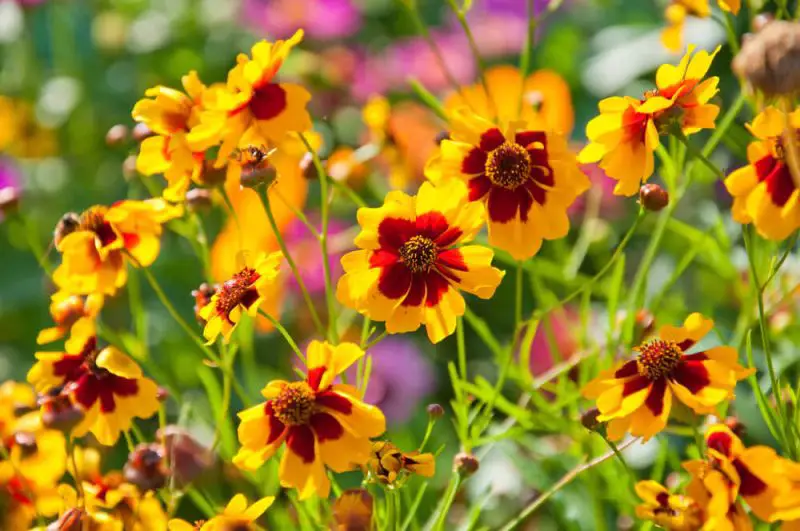Known to many as tickseed, coreopsis is a low-maintenance yet highly rewarding choice for vibrant garden displays. Its cheerful daisy-like blooms in shades of yellow, pink, red, and orange brighten up garden beds, borders, and containers. This hardy perennial is well-loved for its long blooming season, drought tolerance, and minimal maintenance requirements. If you want a garden that bursts with color from early summer through fall, learning how to plant coreopsis correctly is the first step to success.
This guide will walk you through everything you need to know about planting coreopsis, from selecting the best varieties to providing the right soil and sunlight conditions. With proper care and planting techniques, your garden will soon be alive with vibrant flowers that attract butterflies, bees, and beneficial insects.
Understanding Coreopsis and Why It’s Perfect for Your Garden

Coreopsis is native to North America and thrives in a variety of climates, making it a great choice for beginner and experienced gardeners alike. Its name comes from the Greek words “koris” meaning bug and “opsis” meaning view, referring to its seed shape that resembles a tick. Despite the funny name, coreopsis is a true garden gem thanks to its resilience and ability to bloom profusely throughout the warm months.
This plant is available in both perennial and annual varieties, giving you flexibility depending on your gardening needs. Perennial types such as Coreopsis verticillata and Coreopsis grandiflora come back year after year, forming dense clumps that expand over time. Annual varieties, including Coreopsis tinctoria, provide quick bursts of color and often self-seed, creating new plants naturally. Understanding these differences helps you choose the right type for your landscape.
Coreopsis also plays an important role in pollinator gardens. The nectar-rich flowers are magnets for butterflies and bees, making them ideal for gardeners who want to encourage biodiversity. Additionally, their drought tolerance and low maintenance requirements mean you can enjoy continuous color without excessive watering or complicated care routines.
Choosing the Best Coreopsis Varieties for Maximum Color
Selecting the right coreopsis variety is essential for achieving a colorful, long-lasting display. Some varieties produce bold, large flowers, while others have fine, airy foliage with delicate blooms. Coreopsis grandiflora, for instance, is famous for its large golden-yellow flowers, perfect for sunny borders and cottage-style gardens. Coreopsis verticillata, with its thread-like leaves and dense growth habit, creates soft mounds of color ideal for edging pathways or filling gaps between shrubs.
If you prefer something more unique, Coreopsis tinctoria offers bi-colored petals in shades of yellow and reddish-brown, giving a wildflower-like effect. For gardeners who want soft pastel tones, newer hybrids such as Coreopsis rosea produce charming pink flowers that pair beautifully with other summer perennials. By mixing different varieties, you can create layers of color that change slightly as each variety blooms at different times.
Consider your local climate and soil conditions when making your choice. While most coreopsis varieties tolerate poor soil, some hybrids prefer slightly richer conditions. Checking the USDA hardiness zone for your selected variety ensures that your plants will thrive year after year without struggling through harsh winters or overly humid summers.
Preparing the Soil and Site for Healthy Growth
Coreopsis thrives best in well-draining soil and full sun, making site selection one of the most important steps in planting. These plants dislike wet or clay-heavy soils, which can lead to root rot and poor flowering. If your garden soil tends to hold water, amending it with coarse sand, compost, or organic matter can significantly improve drainage. Raised beds are also a great option for areas with compacted or poorly draining soil.
Choose a location that receives at least six hours of direct sunlight daily. While coreopsis can tolerate partial shade, full sun encourages abundant flowering and stronger plant growth. Shaded areas often produce leggy stems with fewer blooms, reducing the vibrant impact coreopsis is known for. Before planting, clear the area of weeds and loosen the soil to about twelve inches deep to give roots room to spread easily.
Soil pH is another consideration, although coreopsis is generally adaptable. Slightly acidic to neutral soil, with a pH between 6.0 and 7.0, is ideal. Testing your soil and adjusting it if necessary can ensure optimal nutrient absorption. Adding compost not only improves soil structure but also provides slow-release nutrients, giving young plants a strong start.
Planting Coreopsis the Right Way for Best Results
Planting coreopsis properly is key to establishing strong, healthy plants. Spring or early summer is the best time to plant, allowing roots to develop before the intense heat of midsummer. In warmer climates, fall planting is also possible, giving the plants a head start for the following spring.
When planting nursery-grown transplants, dig a hole slightly wider than the root ball and set the plant at the same depth it was growing in its container. Firm the soil gently around the roots and water thoroughly to settle it in place. For bare-root divisions or seeds, spacing is important. Coreopsis needs good air circulation to prevent fungal issues, so space plants about twelve to eighteen inches apart, depending on the variety.
If you are starting from seeds, direct sowing into the garden is often easiest. Scatter the seeds over prepared soil, pressing them lightly into the surface without covering them too deeply, as they need light to germinate. Keep the soil slightly moist until seedlings emerge, usually within two to three weeks. Once they are a few inches tall, thin them to the proper spacing for strong, healthy growth.
Watering and Fertilizing for Continuous Blooms
Coreopsis is naturally drought-tolerant once established, but young plants need consistent moisture while developing roots. Water deeply once or twice a week during dry spells, allowing the soil to dry slightly between waterings. Overwatering should be avoided, as soggy soil can quickly lead to root rot.
Fertilizing is not always necessary for coreopsis, especially if your soil is moderately fertile. Excess fertilizer can cause lush foliage at the expense of flowers. However, if your soil is very poor, a light application of balanced, slow-release fertilizer in early spring can boost growth. Compost or organic mulch around the base of the plants also improves soil fertility over time while helping to retain moisture and suppress weeds.
During the peak blooming season, deadheading spent flowers encourages continuous flowering by directing the plant’s energy toward producing new blooms instead of seeds. Regularly removing faded flowers can extend the blooming period well into late summer or even early fall.
Managing Pests, Diseases, and Other Common Problems
Coreopsis is generally resistant to most pests and diseases, making it an excellent choice for low-maintenance gardens. However, certain problems can occasionally appear. Aphids and spider mites sometimes attack tender new growth, especially during hot, dry weather. Washing them off with a strong spray of water or using insecticidal soap can keep infestations under control.
Fungal diseases such as powdery mildew and leaf spot may occur in humid conditions or if plants are overcrowded. Providing proper spacing and ensuring good air circulation is the best preventive measure. If fungal problems develop, removing affected foliage and applying a fungicide can help manage the issue.
Deer and rabbits typically avoid coreopsis due to its slightly bitter foliage, making it a great choice for wildlife-prone gardens. However, occasional nibbling can occur in areas with heavy wildlife pressure. If this becomes a problem, using natural repellents or protective fencing may be necessary.
Pruning, Dividing, and Maintaining Healthy Plants
Regular maintenance keeps coreopsis looking vibrant and ensures long-term health. Deadheading remains the most important task for prolonging blooms, but occasional pruning can also rejuvenate tired plants. Cutting back stems by about one-third after the first major bloom flush often triggers a second wave of flowers later in the season.
Perennial coreopsis varieties benefit from division every two to three years. Over time, clumps can become overcrowded, leading to reduced flowering. Dividing in early spring or fall helps maintain strong growth and gives you additional plants to spread throughout your garden. Simply dig up the clump, separate it into smaller sections, and replant immediately in prepared soil.
In colder regions, leaving the foliage intact through winter can protect the plant crown from frost. Cut back dead growth in early spring to make way for new shoots. Applying a light mulch layer in late fall also helps insulate roots during freezing temperatures, ensuring the plant returns strong in the following growing season.
Companion Planting and Garden Design Ideas
Coreopsis pairs beautifully with many other garden plants, making it a versatile addition to flower beds and borders. Its bright, cheerful blooms contrast well with purple coneflowers, lavender, salvia, and ornamental grasses. Combining these plants creates a naturalistic, meadow-like look that supports pollinators while adding visual movement to the garden.
Because coreopsis has a long bloom period, it serves as an excellent backbone for mixed perennial borders. Taller varieties work well at the middle of flower beds, while compact dwarf varieties make perfect edging plants. Planting in drifts or large clusters enhances their impact, creating a bold splash of color that draws the eye across the garden.
Container gardeners can also enjoy coreopsis by planting compact varieties in pots or window boxes. Combined with trailing plants such as sweet potato vine or creeping Jenny, coreopsis adds bright pops of color to patios and balconies throughout the summer months.
Enjoying a Garden Full of Color Year After Year
Planting coreopsis is one of the simplest ways to bring lasting color and life to your garden. By choosing the right varieties, preparing well-drained soil, and providing proper sunlight, you can enjoy months of cheerful blooms with minimal effort. Regular deadheading, occasional division, and thoughtful companion planting will keep your coreopsis healthy and productive year after year.
Whether you are creating a pollinator-friendly border, filling empty spaces in your flower beds, or adding vibrant color to containers, coreopsis offers endless possibilities. With just a little care and attention, your garden will soon be bursting with the warm, sunny hues that make this plant a favorite among gardeners worldwide.
FAQs about Planting Coreopsis
When is the best time to plant coreopsis?
The best time to plant coreopsis is in spring after the last frost or in early summer. In warmer regions, fall planting is also possible, giving the roots time to establish before the next growing season.
How long does it take for coreopsis to bloom after planting?
Coreopsis grown from transplants may bloom within a few weeks, while those grown from seeds usually take two to three months. Once established, they continue flowering for months.
Does coreopsis need full sun to thrive?
Yes, coreopsis grows best in full sun, requiring at least six hours of direct sunlight daily. Partial shade can reduce flowering and lead to leggy growth.
How often should I water coreopsis?
Water young plants consistently until established, then reduce to once or twice a week during dry periods. Overwatering should be avoided to prevent root rot.
Can coreopsis survive winter?
Perennial coreopsis varieties survive winter in most climates. In colder regions, applying mulch around the base helps protect the roots from freezing temperatures.






